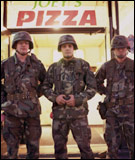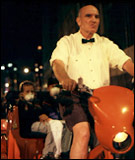
If something is both unthinkable and a cold fact, where to put it? The argument over what edifice will replace the towers has already been joined, but no one is sure what should supplant the city’s collective sense of invincibility. It would be silly to live in fear, but it would be even sillier to go on the same way. As one friend said, “It’s like having new priorities written in the sky.” The effect on New York’s skyline is writ, but it’s worth wondering what kind of rubble the planes created when they pierced New Yorkers’ collective consciousness. It’s not over and never will be.
1. There is no such thing as too informed.
If the attack is something that cannot be explained, at least it can be known. The New York Times tripled its newsstand run and the story pushed the Daily News over a million. Readers became expert on some palpable aspect of the monster. “Of 2,900 samples taken from remains at the scene, feasibility studies on 829 of them showed discernible DNA results, suggesting that the genetic material came from 289 discrete individuals,” one self-appointed experts says. Beats wondering where all the bodies went.
2. Irony is not dead; it abounds. It’s just reverted to form.
Kidnapped by twee practitioners, irony itself ended up in quotes and was used as a cover for collegiate snarkiness by a generation that never had to get serious about anything. Until now. The situational ironies compound horror: the rescuers who are also victims, the firehouse buried in disaster, and a death toll that inexplicably mounts at a site that yields few bodies. And civic discourse is now rife with rhetorical ironies: holy war, the gifts of tragedy, and heroic politicians. This has become a city where people can only smile wanly when its mayor describes New York as “the safest city in the world.” That’s irony in its natural state.
3. Everyone who comes after will never understand.
Not a new brand of New York provincialism but a cold fact. This is the place where the world seemed to end in a single morning. That day, as it was experienced here, was not televised.
4. There is no bridge-and-tunnel, no inner and outer, no us and them.
New York is no longer Manhattan. The attack took place downtown, but the collateral damage perforated the boroughs, Westchester, and close-in Jersey. Forget the wrinkled nose of condescension on the Manhattanite who encounters those who live on the other side of the river and those middle places. Red, white, and blue have suddenly become the new black: In choosing the flag decal as a signifier of the event, New York – a place that Spalding Gray once described as “an island off the coast of America” – has been repatriated. And people elsewhere are flying a different sort of flag in solidarity. “People here are hanging their I NEW YORK T-shirts in their window,” says Minneapolis restaurateur Ed Nagle. They still hate the Yankees, by the way, just not their fans.
5. Everyone has a story and everyone needs to tell it. Over and over.
Survivor stories always end the same way: still here, not there, not dead. The life-affirmingness of that narrative is matched by its singularity: “This is something that happened to me.” A woman in midtown found herself in step with a stranger in a business suit. Apropos of nothing – and everything – he turned to her and said, “I was in the building.” She stopped, reached out automatically to touch his arm. “What floor?” Everyone has a story and everyone needs to tell it. Over and over.
6. The jumpers will always be with us.
Faced with the most horrible of all human choices, the kind of riddle that grade-school children use to torture each other, many leaped rather than burn. And as the debris falling from the top anthropomorphized into human beings, people watching understood that for the time being, we were all beyond help. “I don’t remember faces, just bodies jumping out,” says Alexandra Rethore, a second-year analyst at Lehman Brothers. “And the girl next to me was hysterical. She kept saying, ‘They’re catching them, right?’ I said, ‘Yeah, they’re catching them. Let’s go.’ ” It was a noble act, a message to loved ones: “I’m gone but not lost. I’m still here. Find me.”
7. Everything going forward, apart from life itself, is a misdemeanor.
To complain about a job, a girlfriend, or an extra seven pounds in this new day is to invite disbelief. It ain’t arms and legs, right?
8. Strangers aren’t that strange anymore, unless they are.
Our interest in people we don’t know cuts two ways. On the subway, we scan the car, examining people as potential threats – Is he the kind of man who would sell me a bagel or blow this car up? But after we’ve checked out features, backpacks, and mien, sometimes the eyes actually meet. And the look is returned with an understanding that at any minute, if things go wrong, we could come to know each other so much better. A woman on the 4 train sat down next to a man and began riffling through a document from the Federal Emergency Management Agency – the topic joined, they talked until she got off, sharing vulnerabilities, theories, and a ten-minute train ride.
9. The line between urban reality and urban legend is shrinking.
How is it that the most extraordinary acts in the history of Western civilization still prompt people to embellish? Yes, it is true that one of the firefighters was killed when one of the people he was there to save landed on him, but no, it is not true that a cop surfed his way down from the eightieth floor on a concrete slab. There’s a high correlation between terror and gullibility, apparently. And then there is the subgenre of stories that are true but too horrible to be told, such as that of the cop, trapped in rubble with two broken legs, who died from a self-administered bullet.
10. The house in the country has become the new Cold War’s bomb shelter.
What had been a signifier of status has become that other place where we will go when the shit hits the fan. Leslee Dart, president of PMK/HBH, closed down her office and sent people home by 10:30. By 11:30, she – along with her husband, child, nanny, and a co-worker – was on her way to Garrison, an hour and a half north of the mayhem. “It felt like the safest place to be,” she says.
11. It’s good, not silly, to have a plan. And some running shoes in the drawer.
You leave breakfast with a friend, shaking your head about his interest in having an anthrax palliative on hand – and later find yourself surfing the Web in pursuit of same. Then one of the cute girls in the office mentions that she’s wondering how to accessorize her new gas mask that she plans on carrying with her all the time: “I can keep it in my handbag with my makeup and tampons, so no one will ever know.” It’s all good. If having climbing gear in your forty-fourth-floor office makes you feel one iota safer, rock on. Oh, and let’s not forget sensible shoes. Now Manolos and shimmy dresses have given way to “flee wear,” a look that’s bound to flatter the girl who’s running for her life.
12. Being scared and being tough are the same thing.

Tough is not insouciance and a leather coat. Tough is hanging in even though one of your friends is gone. Or going to work even though your house is unlivable. Or heading down into the subway even though a sense of foreboding walks with you. “I feel like I don’t want to stay here because I am scared, but I don’t want to leave because I am more scared of people who haven’t been through this,” says Robyn Forest of the Lower East Side. The people who aren’t scared are the people who have nothing to lose. Losers.
13. Below the radar is the trendiest place to be.
Low-rise, nothing-special-here New York seems like the last safe place. And New Yorkers now actually have a reason, other than pure snobbery, to avoid the places where tourists mass. Big is out, crowds are scary, as is anything that could be construed as an icon. Commuters still brave Grand Central but think twice before lingering for oysters and beer.
14. Evil now has an address.
Does the World Trade Center continue to smoke because it’s still on fire or because a hole has been punched into Hades itself? No matter. There are $6,000 watches strewn about, a cache of gold in the basement, and lessons in the evanescence of human endeavors everywhere. It became immediately sacred, a construction site in reverse that also happens to be a burial ground. The most televised piece of real estate in the history of civilization can be comprehended only up close. “You can turn off the TV,” says Diane Rooney of Minnesota, looking at the wreck. “Here it is real. All that you can think of is the sorrow and overwhelming loss.”
15. There have always been people crying on the streets of New York. Now we know why.
Did you ever think the person weeping openly on the sidewalk in front of the bodega would be you? Public crying has become and will remain socially acceptable for a long time to come. Plane sound a little loud? Go ahead and bawl. Check a downtown avenue to get your bearings? Have a tissue. Wrong page of the Rolodex? Don’t bother to close the office door.
16. Certain places in New York will never be the same.
Common parts of the city have been indelibly marked by uncommon events. The city work crews came through Union Square last Thursday morning and stuffed the impromptu memorials and sculptures into black garbage bags: “We’re just finishing what the rain started.” The square’s status as a kind of holy place will linger even as children and dogs retake the park. Staten Island ferried in brave, talented men and got back an empty boat. And the armory’s service as a nexus of human grief created ghosts that time won’t rub out.
17. Trade Center metaphors are inescapable and in perpetually bad taste.
Five homicide detectives were drinking at Peter McManus on Seventh last week and telling work stories, including one about punching a perp in the face: “He was out of his mind. I hit him and he dropped like the World Trade Center.”
18. The dust will be with us forever.
All the efforts at civic hygiene can’t erase the past. That dust has become the spot that the Cat in the Hat could never get rid of. No one admits that it contains some fraction of the victims themselves, because to say so aloud would make it tough to draw breath. Underneath the rail at the downtown Chambers A-C-E stop, or in between the slats of a bench on the boulevard of Allen Street, the dust hides and waits, a tiny reminder of big things that never go away.
– Additional reporting by Jada Yuan